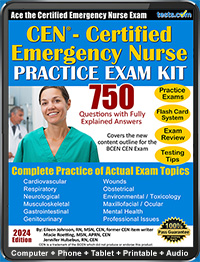CEN Practice Exam
Try our free CEN Practice Exam below written by CEN experts. Your results will be scored automatically and will display your strengths and weaknesses.
A nurse who wishes to obtain the Certified Emergency Nurse (CEN) credential must take and pass the CEN exam which is administered by the Board of Certification of Emergency Nursing (BCEN). The CEN exam is composed of 175 multiple choice questions and you are given three hours to complete the exam.There are twelve areas tested on the CEN exam: Cardiovascular - Respiratory - Medical Emergencies and Infections - Neurological - Orthopedics and Wounds - Gastrointestinal - Genitourinary, Gynecological and Obstetrical - Environment and Toxicology - Professional issues - Shock - Maxillofacial and Ocular – Psychosocial.The CEN exam tests your ability to use the Nursing Process within the context of Emergency nursing. Throughout the test, you can expect to see questions that will test your assessment, analysis, intervention and evaluation knowledge.
For complete practice, check out the CEN Practice Exam Kit with 750 questions and fully explained answers.
Jennifer Hulsebus, RN, CEN
Eileen Johnson, RN, MSN
A nurse who wishes to obtain the Certified Emergency Nurse (CEN) credential must take and pass the CEN exam which is administered by the Board of Certification of Emergency Nursing (BCEN).
The CEN exam tests your ability to use the Nursing Process within the context of Emergency Nursing. Throughout the test, you can expect to see questions that will test your assessment, analysis, intervention and evaluation knowledge. The CEN exam is composed of 175 multiple choice questions and covers the following twelve areas:
- Cardiovascular
- Respiratory
- Medical Emergencies and Infections
- Neurological
- Orthopedics and Wounds
- Gastrointestinal
- Genitourinary, Gynecological and Obstetrical
- Environment and Toxicology
- Professional issues
- Shock
- Maxillofacial and Ocular
- Psychosocial




